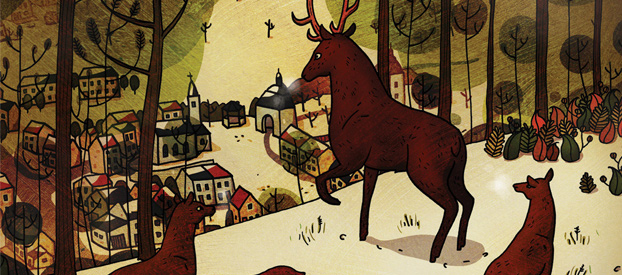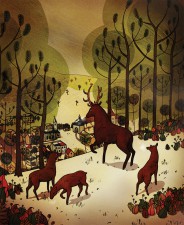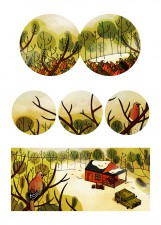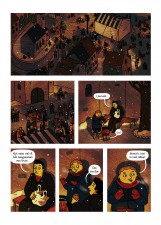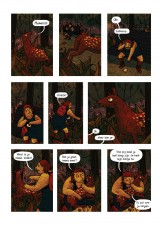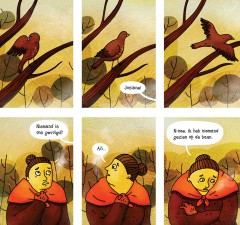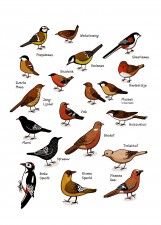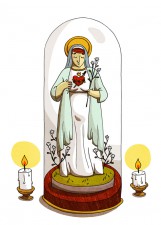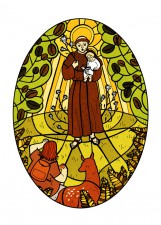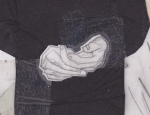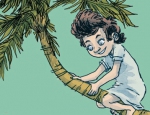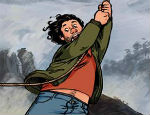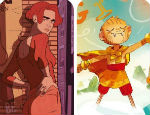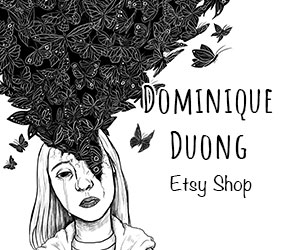A mysterious fertility stone with Christian roots, an enigmatic deer patron, a small village in the Belgian Ardennes and a population that thrives on folklore and tourism but most of all on small human interactions and the surprising revelations that come from them. The Miracle of Vierves, the debut album from Belgian artist Inne Haine, displays a keen eye for storytelling coupled with a great graphic sensibility for a first outing. Her album would not be out of place in the portfolio of UK publisher Nobrow, for example. High time for a little chat, then.
Broken Frontier: You mentioned that the story started evolving at a workshop you did, but what pushed you further to turn it into a full-blown graphic novel?
Inne Haine: During the workshop, at the tiny village of Vierves-sur-Virion, I sketched a story of about 30 pages in one week. That was during the final year of my illustration-comics course. I had a really great time and just felt that there was more to it. One of our teachers, all-time-great Dutch illustrator Hanco Kolk had the same opinion and suggested I put more layers to the story.
As a graduation project, though, it was much too ambitious, so the story outline I created during the workshop turned out to be the first chapter of the OGN.
The graphic novel also oozes a predilection for the working man – the commoner who takes life as it comes and stubbornly adheres to his routines. Is this a part of your work ethic or do you tend to contemplate life a bit more?
I am quite melancholic myself and spend a lot of time thinking about life and stuff. But I’m also quite hard-headed, and I like it when things move ahead. It depends on the situation, I guess.
If the same thing happened to me as happens to François in the graphic novel – the incident that influences the whole village – I think my breakdown would come much sooner. He tries to cover up the truth and is quite clumsy about it. But, then again, it is fun to create such a character, and he serves as a comical counterbalance to the more dramatic happenings.
It all starts quite vaudeville but then transforms itself into a tragical comedy, with a dash of bildungsroman.
I really like that mix of humour and tragedy, whether it’s in comics, TV series or movies. I have a low tolerance for superhero stories, since we all know how they end beforehand. I’d rather have an anti-hero or a protagonist that is more haunted, like Chris Ware’s Jimmy Corrigan.
The coming-of-age aspect of Arnauld was necessary for the story since it spans quite a large time frame. You can make up all kinds of things to tell a kid because sometimes the truth hurts. So as he grows up – and during the reading of the graphic novel – it also becomes apparent that not all things are as they were presented previously.
How did you arrive at your drawing style? Is it mostly digital or analogue?
I do have a drawing tablet connected to my computer, but the smooth plastic board doesn’t feel the same as a piece of paper. Paper just feels much nicer and cleaner. I want to be able to feel my work. In the end, you get a stack of like 300 pages and then I think “Wow, did I really draw all that?”, but it does give me a lot of satisfaction.
The colouring is completely digital, though, due to the speed and practicality. I did use a lot of textures to make it feel a bit painterly.
What inspires you to create your own stories?
For The Miracle of Vierves I imagined what it would be like to grow up in an out-of-the-way village that thrives on tourism. What would happen if the one thing was taken away that threatens the future of that village, and what conflict would rise from that dilemma?
I think I’m inspired a lot by daily life. People go about their lives and then suddenly something changes – how do you deal with that? Sometimes people want to re-invent themselves, but that is not always so easy.
What lies ahead for you in the future?
I’m collaborating with my friend Mathias Van den Berge on a new story featuring the carnival singer of The Miracle of Vierves. He desperately tries to “make it” but has trouble breaking loose from daily routine. His boring job and uninterested daughter keep him grounded, but he still dreams of a glorious career as a singer.
I’m guessing it will turn out to be a rather comical story but tackling the big question that everyone struggles with: what to do with your life.
The Miracle of Vierves by Inne Haine is published in Dutch by Oogachtend. It is a full-color hardback counting 144 pages and retails for €24. Follow Inne Haine on her blog.
For more news and info from Europe’s comics community, follow me on Twitter right here.





